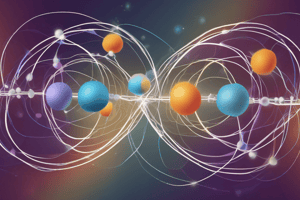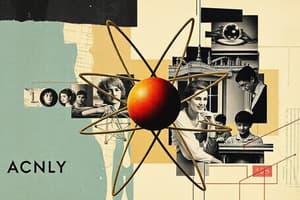Podcast
Questions and Answers
What determines the identity of an element?
What determines the identity of an element?
- The atomic mass
- The number of electrons
- The number of neutrons
- The number of protons (correct)
Isotopes of an element have the same number of protons but a different number of electrons.
Isotopes of an element have the same number of protons but a different number of electrons.
False (B)
What is the outermost electron shell of an atom called, and what is its significance?
What is the outermost electron shell of an atom called, and what is its significance?
valence shell; determines reactivity
Atoms that lose electrons become positively charged ________, while atoms that gain electrons become negatively charged ________.
Atoms that lose electrons become positively charged ________, while atoms that gain electrons become negatively charged ________.
Which characteristic of water is primarily responsible for surface tension?
Which characteristic of water is primarily responsible for surface tension?
Hydrophobic compounds are generally polar and readily dissolve in water.
Hydrophobic compounds are generally polar and readily dissolve in water.
Match the type of chemical bond with its description:
Match the type of chemical bond with its description:
What type of reaction involves the combination of molecules with the release of a water molecule?
What type of reaction involves the combination of molecules with the release of a water molecule?
Which of the following is true regarding the strength of covalent bonds?
Which of the following is true regarding the strength of covalent bonds?
Electronegativity refers to an atom's ability get rid of electrons in a covalent bond.
Electronegativity refers to an atom's ability get rid of electrons in a covalent bond.
A solution with a pH of 3 is considered ______.
A solution with a pH of 3 is considered ______.
Match the functional group with its corresponding chemical formula:
Match the functional group with its corresponding chemical formula:
Explain the difference between atomic mass and atomic number.
Explain the difference between atomic mass and atomic number.
Which of the following best describes the role of a buffer?
Which of the following best describes the role of a buffer?
Which subatomic particles are located in the nucleus of an atom?
Which subatomic particles are located in the nucleus of an atom?
The K-level energy level can contain a maximum of ________ electrons.
The K-level energy level can contain a maximum of ________ electrons.
Which of the following macromolecules is primarily used for long-term energy storage?
Which of the following macromolecules is primarily used for long-term energy storage?
Enzymes increase the activation energy required for a reaction to occur.
Enzymes increase the activation energy required for a reaction to occur.
What determines the primary structure of a protein?
What determines the primary structure of a protein?
In DNA, adenine pairs with ______, while guanine pairs with cytosine.
In DNA, adenine pairs with ______, while guanine pairs with cytosine.
Flashcards
Elements
Elements
Pure substances made of only one type of atom or molecule.
Atomic Number
Atomic Number
The number of protons or electrons in an atom.
Protons
Protons
Positively charged particles in the nucleus of an atom.
Neutrons
Neutrons
Signup and view all the flashcards
Electrons
Electrons
Signup and view all the flashcards
Atomic Mass
Atomic Mass
Signup and view all the flashcards
Isotopes
Isotopes
Signup and view all the flashcards
Valence Electrons
Valence Electrons
Signup and view all the flashcards
Cations
Cations
Signup and view all the flashcards
Covalent Bonding
Covalent Bonding
Signup and view all the flashcards
Electronegativity
Electronegativity
Signup and view all the flashcards
Cohesion (Water)
Cohesion (Water)
Signup and view all the flashcards
Adhesion (Water)
Adhesion (Water)
Signup and view all the flashcards
Acids
Acids
Signup and view all the flashcards
Bases
Bases
Signup and view all the flashcards
Buffers
Buffers
Signup and view all the flashcards
Carbonyl Group
Carbonyl Group
Signup and view all the flashcards
Carboxyl Group (-COOH)
Carboxyl Group (-COOH)
Signup and view all the flashcards
Monosaccharides
Monosaccharides
Signup and view all the flashcards
Triglyceride
Triglyceride
Signup and view all the flashcards
Study Notes
- Here are your study notes
Elements
- Pure substances are composed of only one type of atom or molecule
- Atoms are comprised of protons, electrons, and neutrons.
- Protons have a positive charge.
- Electrons have a negative charge.
- Neutrons have no charge.
- Protons and neutrons reside in the nucleus, while electrons orbit in surrounding orbitals
- Atomic Number: equals the number of protons or electrons in an atom.
- Atomic Mass: equals the number of protons plus neutrons in an atom; the average mass is given
- Isotopes: The number of neutrons changes, altering the atomic mass, while the number of protons and electrons remains constant
- Unstable isotopes are radioactive and emit particles or energy.
Electrons
- Negatively charged, surround atomic nuclei
- They balance out positively charged protons for stability
- So small that mass isn't counted
- Electrons exist in an electron cloud, comprised of energy levels & orbitals
- Energy Levels: represented as K, L, M, ...
- Orbitals: S, P, D, F
- K-level: the lowest energy level, contains 2e- of a circular S orbital; can contain a maximum of 2e-
- L-level: includes S & P orbitals
- P orbitals are made of ‘dumbbell' shapes on x,y,z axes
- Each P orbital can hold 2e-, creating a total of 6e-
- S & P orbitals together hold a maximum of 8e-
- Valence Electrons-Outermost e- of atom
- Valence Electrons-Used in chemical reactions
- Valence Electrons-Determine the atom's reactivity
Reactivity and Bonding
- To achieve stability, atoms aim to fill their valence shell by giving, taking, or sharing in order to reach stability
- Nonstable atoms have nonneutral charges and become ions
- Atoms that give up an electron become cations (+).
- Atoms that take in an electrons become anions (-).
- 1 metal & 1 nonmetal give/take electrons
- Cation + Anion = neutral compound (ex- Na(+1) + Cl(-1) = NaCl)
- The ionic bond will be stronger the greater the difference in ion charges
- Ionic Bonding create polar bonds
Covalent Bonding
- Covalent Bonding entails two nonmetals that shares of electrons.
- Covalent Bonding makes three types of bonds
- Single; weakest
- Double; intermediate
- Triple; strongest
- Polarity depends
Properties of Water
- Electronegativity & Polarity
- Electronegative atom has high affinity for taking electrons; ex: Halogens (F, Cl, Br, I) and Oxygen
- Metals on the far left of the Periodic Table are the least electronegative and more readily gives up e-
- The greater the difference in electronegativity between atoms in a molecule, the more polar that molecule will be; ex. Water (H2O)
- Atoms with similar electronegativity will be less polar to nonpolar; ex. H2, F2
- Cohesion occurs because Water molecules stick to other water molecules due to hydrogen bonding
- Cohesion of water Creates a high surface tension; can be broken by a surfactant
- Adhesion is the process of water molecules sticking to to other polar, non-water molecules
- Water acts as the universal solvent as it Dissolves other polar compounds and hydrophilic compounds/ionic bonds
- Hydrophobic compounds are generally nonpolar and repel water
Water Reactions
- Dehydration Synthesis: Molecules combine and spit out a water molecule
- Hydrolysis: Molecules broken apart by presence of water
pH, Acids, Bases, Buffers
- pH Scale ranges From 0-14 where
- 0-6 is acidic
- 7 is neutral
- 8-14 is basic/alkaline
- Acids: Release H+ ions (a proton) when dissolved in water
- Bases: OH- (hydroxide ions) absorb H+ ions, reducing acidity of solution
- Buffers: Resist changes in pH when small amounts of acids/bases are added; usually includes a salt
Functional Groups
- Hydroxyl Groups (R-OH): Single bonded to OH; found in alcohols; simplest = methanol/methylachohol
- Carbonyl Groups (R-C=O): Carbon double bonded to oxygen; found in multiple groups of compounds; ex- Aldehydes/formaldehyde; Esters make an "L" shape; Ketones make a "T" shape
- Carboxyl Groups: combination of hydroxyl and carbonyl groups; and the group that is Found in organic acids; formic acid
- Amino/Amine Groups: NH2; Found in amino acids/organic acids (carboxyl group) + amine group; Simplest = glycine
Macromolecules
- Carbohydrates are Made of carbon, oxygen, and hydrogen primarily
- Carbohydrates' C-H bonds contain energy for quick usage
- Carbohydrate Monomers = monosaccharides (can be aldehydes or ketones); simple sugars; ring shaped; end with suffix -ose
- Grouped by # of carbons; ex: Pentose (5), Hexose (6)
- Monosaccharides are combined into disaccharide polymers via dehydration synthesis
- Glucose can be made into disaccharides
- Hexose; has alpha & beta forms determined by the position of hydroxyl groups
- Glucose has a carbonyl group
- Fructose has a ketone
- Galactose is a mirror of glucose
- Alpha glucose + alpha glucose = Maltose
- Glucose + Fructose = Sucrose
- Glucose + Galactose = Lactose
- Polysaccharides
- Alpha glucose = branched polymer (Starches, glycogen)
- Beta glucose = unbranched polymer (Cellulose)
- Lipids
- Comprised of C, O, H
- C-H bonds contain energy for long-term storage
- Lipids are hydrophobic/nonpolar
- Examples of Lipids: oils, fats, waxes
- Triglyceride: Glycerol + 3 fatty acids
- Steroids
- Cholesterol made from saturated fats
- Hormones
- Glucose converted into starches, then excesses made into triglycerides by liver for energy storage
- High Density Lipoprotein - HDL - "Good" cholesterol
- Low Density Lipoprotein - LDL - "Bad" cholesterol
- Proteins consist of Monomers = amino acids that Contain amino & carboxyl groups, and amine/organic acids
- Protein's simplest form is glycine
- Peptide bonds link monomers into polymers
- Polypeptides named by the number of amino acids being bonded together
- Ex: 2 amino acids bound by 1 peptide bond = dipeptide
Polypeptide Structures
- Primary sequence: amino acid sequence
- Secondary sequence: primary sequences together in 3D space
- Alpha helices
- Beta pleated sheets
- Tertiary sequence: Secondary structures folded back on each other
- Globular proteins
- Enzymes
- Quaternary sequence: Multiple tertiary structures together
- Hemoglobin, hemocyanin
- Enzymes cont'd
- Act as Tertiary proteins, catalyze reactions, and end in -ase
- Specific substrates bind to specific active sites
- Denatured by heat; bonds break and lose function
Nucleic Acids
- The three major components of nucleotide monomers:
- Pentose sugar
- Phosphate group
- Nitrogenous base
- Nitrogenous Bases cont'd
- Purines; 2 ring structure (Adenine, Guanine)
- Pyrimidines; 1 ring structure (Thymine, Cytosine, Uracil)
- Purines & pyrimidines bond to one another across DNA strands with hydrogen bonds: A&T/U, G&C
- Deoxyribonucleic Acid (DNA) is a Double stranded helix
- Its Deoxyribose sugar Uses Thymine
- Ribonucleic Acid (RNA) is a Single strand, Ribose sugar
- Ribonucleic Acid Uses uracil
Studying That Suits You
Use AI to generate personalized quizzes and flashcards to suit your learning preferences.




